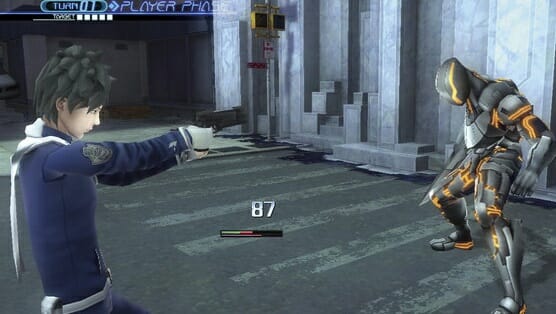Lost Dimension: All the Cool Kids Go to the Post-Apocalypse Murder Tower
Games Reviews The Cool Kids
As An Idea For A Videogame, Lost Dimension is amazing. As a Collection Of Discreet Systems, it’s pretty good. As an Actually Executed Videogame it’s quite bland. Lost Dimension is a videogame you’ll get more out of reading a review of than actually playing, and if that sounds cool to you, you might want to actually play it. This is a game destined to be a dismissed near-miss until someone unearths it a decade later and can’t believe what forgotten and clever ideas it tried to execute on.
The “Idea For A Videogame” in Lost Dimension is a good idea though: 11 anime teen psychics are trapped in some arbitrary tower and must fight pretty fun strategy RPG battles to stop a villain with frosted tips from destroying the world, but every time they reach a new floor they have to vote to kill one of their own members to progress. If you can figure out which one of your friends is secretly a traitor, and influence everyone to erase them, you can feel much less guilty about murdering a friend to progress! How cruel and horrifying! How perfect and beautiful a premise for trembling violent teen anime melodrama!
And as very obviously derivative as it is from Danganronpa, Lost Dimension’s particular take has some fascinating social mechanics. First of all, the traitors are randomized every playthrough so it’s actually at least in that respect spoiler-proof. The way you find the traitor is a multi-step process—after you complete a mission, the protagonist uses his precognition to hear voices from the people who participated, which indicates the number of suspected traitors among them (there are three total per segment). This has a clever effect of forcing you to experiment with different teams and use every character to narrow down which are the suspects. Once you know who is a suspect, you can dive into the character’s mind by spending a very limited resource and completing a minigame to confirm them as traitor or not conclusively.

So, here is a system set up for the creation of melodrama, betrayal and tragedy. But it is the next step of the process, the final vote to eliminate a member, that actually ends up making this a game about cliques and popularity instead. Finding the traitor is the relatively easy part. The hard part is convincing everyone to vote to kill them. To do this, you’ll have to get everyone to like you by having conversations that sort of develop their lackluster characters, give people advice when they ask you after you complete a mission, and engineer the voting process because the three members with the highest scores on missions get extra votes. There’s a screen that tells you how much a character is liked by others, and you can guide characters to popularity or ostracize them easily simply by deciding who gets to go on missions. That is a chillingly creepy and accurate representation of teen social dynamics on a systemic level!
The potential of Lost Dimension’s systems and premise as a betray-‘em-up don’t actually turn out too well in practice, because it’s all system and no substance. The system is set up for you to ostracize and kill people you were fighting alongside and making friends with before they betray you! But as fascinating as that is on paper, Lost Dimension can in basically no way at all make that procedurally generated betrayal actually dramatic. For such a snubbed art, melodrama is much harder to craft than it looks. You need big characters and big personalities, and most importantly of all, they need time and space and circumstance to bounce off of each other, and the randomized nature of the betrayal makes it cost prohibitive to write dramatic conversations for every possible combination of people—meaning that the payoff of the betrayals is anticlimactic and boring. The characters are flat and say the same things to each other.
The meteoric success of Danganronpa (Lost Dimension’s direct influence) has almost everything to do with its cast of over the top, super-high-school-level characters with loud, vibrant personalities who need to butt heads and get into conflict enough that they end up murdering each other. That they’re full of tropes and clichés is useful for establishing them and also sets it up for them to subvert expectations at the very last minute. Danganronpa is silly and humorous on purpose, laughing at its own ludicrousness until playing it straight at the most devastating possible moment. The drama there isn’t an accident, but well crafted, and Lost Dimension can’t replicate with systems the feelings that Danganronpa, or Persona, or Fire Emblem, or the successful examples in this genre evoke with linearity.
As a designer, I think that’s interesting—and I can feel potential in the way becoming a bullying clique clicked so suddenly and obviously as the way to beat the game. But games are a lot more than just the system facilitating drama. Until we’re at the point where AIs can play all these characters, we’re going to have to fall back on humans who can write. I hope someday someone remembers this game, and figures out how to reconcile the stories with the system.
Lost Dimension was developed by Lancarse and published by Atlus. It is available for the PlayStation 3 and Vita.
Aevee Bee is freelance writer who maintains a surreal videogame terror blog at mammonmachine.com and a twitter account, @mammonmachine, which is both a popular resource for anime puns and flirtation advice.